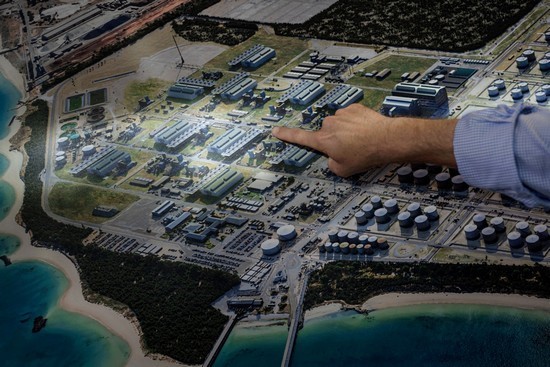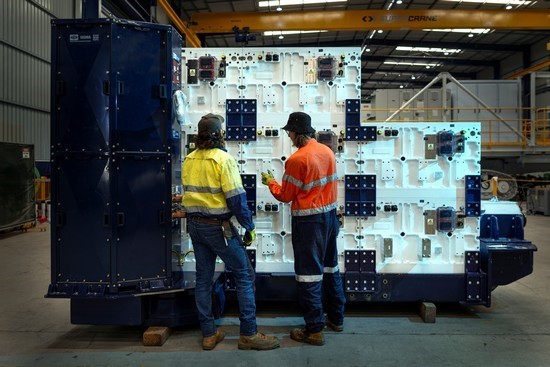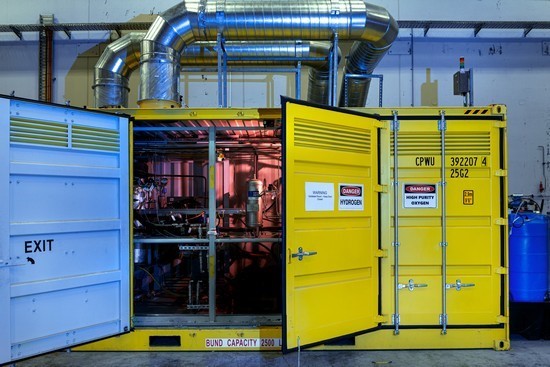For eons, this has been a quiet,
unremarkable place — thousands of square kilometers of flat land covered in
shrubs and red dirt. The sun is withering, and the wind blows hard.
اضافة اعلان
It is exactly those features that qualify
this remote parcel of the Australian Outback for an imminent transformation. A
consortium of energy companies led by BP plans to cover an expanse of land
eight times as large as New York City with as many as 1,743 wind turbines, each
nearly as tall as the Empire State Building, along with 10 million or so solar
panels and more than 1,600km of access roads to connect them all.
But none of the 26 gigawatts of energy the
site expects to produce, equivalent to one-third of what Australia’s grid
currently requires, will go toward public use. Instead, it will be used to
manufacture a novel kind of industrial fuel: green hydrogen.
If the rosiest projections hold, green hydrogen in heavy industry could reduce global carbon emissions by 5 percent, if not two or three times.
This patch of desert, more than 160km from
the nearest town, sits next to the biggest problem that green hydrogen could
help solve: vast iron ore mines that are full of machines powered by immense
amounts of dirty fossil fuels. Three of the world’s four biggest ore miners
operate dozens of mines here.
Proponents hope green hydrogen will clean
up not only mining but also other industries by replacing fossil fuel use in
steelmaking, shipping, cement and elsewhere.
 A rendering at a BP facility on the outskirts of Perth
of a planned hydrogen production site in the Pilbara region of Western
Australia
A rendering at a BP facility on the outskirts of Perth
of a planned hydrogen production site in the Pilbara region of Western
Australia
Green hydrogen is made by using renewable
electricity to split water’s molecules. (Currently, most hydrogen is made by
using natural gas, a fossil fuel.) The hydrogen is then burned to power
vehicles or do other work. Because burning hydrogen emits only water vapor,
green hydrogen avoids carbon dioxide emissions from beginning to end.
A wind and solar energy replacement?In the Pilbara region of Western Australia
and in dozens of spots around the globe endowed with abundant wind and sun,
investors see an opportunity to generate renewable electricity so cheaply that
using it to make green hydrogen becomes economical. Even if only some of the
projects come to fruition, vast stretches of land would be duly transformed.
 An electric battery prototype for a Fortescue Metals
Group ore-hauling truck at a facility on the outskirts of Perth, Australia.
An electric battery prototype for a Fortescue Metals
Group ore-hauling truck at a facility on the outskirts of Perth, Australia.
The project is one example of a global
gamble, worth hundreds of billions of dollars, being made by investors,
including some of the most polluting industries in the world.
Last year, government subsidies sped up
action in the European Union, India, Australia, the US, and elsewhere. The
Inflation Reduction Act, the Biden administration’s landmark climate
legislation, aims to drive the domestic cost of green hydrogen down to
one-quarter of what it is now in less than a decade through tax incentives and
$9.5 billion in grants.
Nearly 40 percent of the world’s iron ore comes from the Pilbara. Wherever you are, when you look out at the world, some of what you see is likely born of materials mined in and around Christmas Creek.
“We are about to jump from the starting
blocks,” said Anja-Isabel Dotzenrath, who once led Germany’s biggest renewable
energy company and now runs BP’s gas and low-carbon operations. “I think
hydrogen will grow even faster than wind and solar have.”
Not everyone sees it that way. Challenges
loom on every level, from molecular to geopolitical.
Some energy experts say green hydrogen’s business
rationale is mostly hype. Doubters accuse its champions of self-interest or
even self-delusion. Others see hydrogen as diverting crucial investment away
from surer emissions-reduction technologies, presenting a threat to climate
action.
Still, if the rosiest projections hold,
green hydrogen in heavy industry could reduce global carbon emissions by 5
percent, if not two or three times that. In those scenarios, which are far from
certain, hydrogen plays a crucial role in limiting global warming.
Fatih Birol, the Turkish economist who
leads the International Energy Agency, said he seldom meets people who do not
find green hydrogen alluring, with its elegant elementality. His organization
forecasts that green hydrogen will fulfill 10 percent of global energy needs by
2050.
 A Fortescue electrolyzer, used to break water down
into hydrogen and oxygen.
A Fortescue electrolyzer, used to break water down
into hydrogen and oxygen.
He said the agency’s expectations were
based on the fact that, if the world wants to limit warming to 1.5 degrees, “so
much green hydrogen needs to be part of the game”.
A ‘monstrous challenge’For green hydrogen to have a substantial
climate impact, its most essential use will be in steelmaking, a sprawling
industry that produces nearly one-tenth of global carbon dioxide emissions —
more than all the world’s cars.
In climate lingo, steel emissions are “hard
to abate”. Blast furnaces, freight trains, cargo ships, and the gargantuan
trucks used in mining require heavy fuels like coal and oil. Even if they could
be electrified (and, as a practical matter, today many cannot be), they would
strain grids enormously.
Day and night, 3-km-long ore trains
weighing more than 40 million kilograms depart Christmas Creek for Port
Hedland. From the port, an endless stream of cargo ships (once again, burning
heavy fuel) sail for East Asia, where ore becomes steel in coal-burning mills.
To liquefy hydrogen for shipping, it must be chilled to negative 252.87 degrees Celsius, just shy of absolute zero, the theoretical temperature at which atoms are completely still.
Nearly 40 percent of the world’s iron ore
comes from the Pilbara. Wherever you are, when you look out at the world, some
of what you see is likely born of materials mined in and around Christmas
Creek.
It would not be an overstatement to call
the mine’s owner, Andrew Forrest, the most bullish of hydrogen’s backers. When
he said two years ago that he was going to rapidly switch the mining operations
of his company, Fortescue Metals Group, to running fully on electric batteries,
green hydrogen, and green ammonia, a fuel derived from hydrogen, he was “met
with mirth”, he said recently.
“Back then, there was a distinct, visible
horizon of disbelief that the world could actually change,” said Forrest, who
is also one of the richest people in the world. He is adamant that there is a
market, even if others see folly.
Both Fortescue and BP envision themselves
as vying for the lead in green hydrogen and have announced plans to invest
hundreds of billions of dollars in projects across dozens of countries beyond
Australia, from Oman to Mauritania to Brazil and the US. Those would still
account for only a smidgen of the hundreds of millions of tonnes the IEA and
others say would be needed to create a market in which green hydrogen was cheap
enough that steel and concrete makers were convinced to convert their
operations.
Even though both companies are hugely
profitable, Australia’s government has made hundreds of millions of dollars
available to them through subsidies and land allocations over the past two
years, mostly in Western Australia, which is six times the size of California
but has only 2 million people.
“Diesel has had 120 years to become
plentiful and affordable,” said Jim Herring, who oversees Fortescue’s green
industry development. “We want to scale hydrogen up in a tenth of that time.
It’s a monstrous challenge, honestly.”
The ‘absolute zero’ problemTo liquefy hydrogen for shipping, it must
be chilled to negative 252.87 degrees Celsius, just shy of absolute zero, the
theoretical temperature at which atoms are completely still. Hydrogen is also
very flammable, making storage difficult.
They are just two of many obstacles.
Saul Griffith, a prominent inventor in renewable
energy who started his career at an Australian steel mill, does not see a big
role for green hydrogen. To replace fossil fuels, he said, “the electricity you
use to make it would have to be ridiculously cheap. And if you have that, why
use it to make hydrogen?”
He calls it “not a fuel that will save the
world”. Better to spend the money, he and others argue, on reducing renewable
electricity costs so that nearly everything can be electrified.
Forrest said skeptics simply lack
scientific knowledge. Fortescue, he said, will mix hydrogen with carbon dioxide
so it is similar enough in consistency to liquefied natural gas that it can be
transported in the same tankers.
“It’s is as simple as it sounds,” he said.
Forrest said he believed that by decade’s
end, he would save his shareholders at least $1 billion a year by converting
mining operations to green hydrogen and that his company would ultimately
produce hydrogen at dozens of sites worldwide. BP said it will be exporting
large quantities of green hydrogen and ammonia by then, too.
Read more Technology
Jordan News



